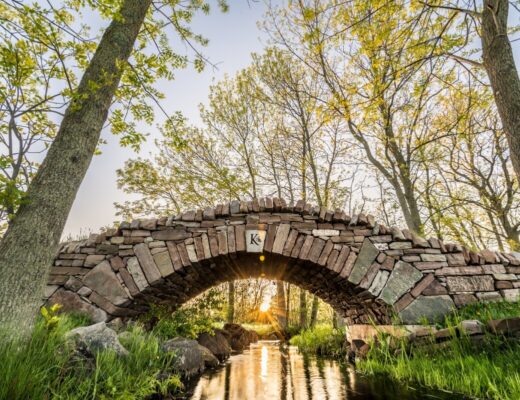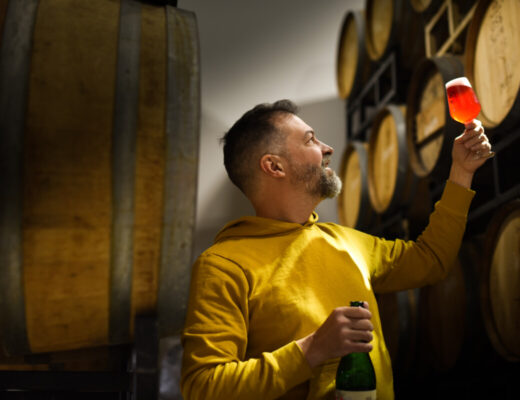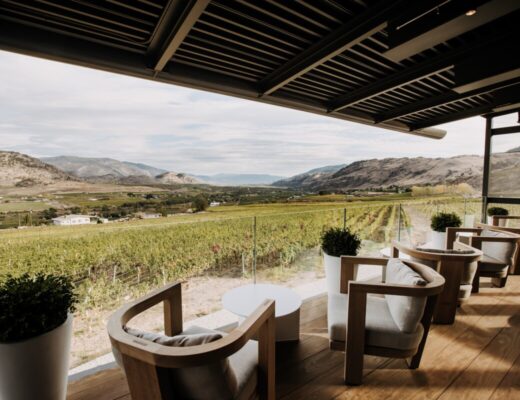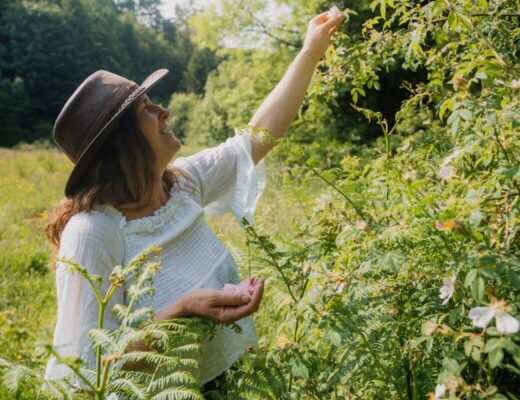Meet Ontario wine’s new power couple
Katie Dickieson is the head winemaker (since 2012) at Niagara’s Peller Estates and Nik Antunovich is the winemaker/consultant behind several Ontario wineries – Cooper’s Hawk Vineyards, Burning Kiln Winery, Colio Estate Wines and Coffin Ridge Boutique Winery. In addition to winemaking and consulting, Nik represents the French cooperage of Tonnellerie de Mercurey providing French oak barrels to wineries.
So, you might ask, what’s a power couple? A power couple consists of partners who complement each other’s strengths and support each other’s individuality, while also thriving as a family. That pretty much describes Katie and Nik who share three lovely daughters (ages four, six and eight) and have busy individual careers.
Read Also: Winemaker Q&A: Five questions for Barclay Robinson
I sat down with Katie and Nik to learn more about their winemaking careers and how they make time for family life.
Katie likes to describe herself as a farm girl. She grew up in a farming family near Palmerston, Ontario. There she developed an appreciation for the land, agricultural work in general, and learned to love the frenetic activity around harvest time. She majored in Food Science at the University of Guelph, and then became a member of the winemaking team at Niagara’s Peller Estates. She’s spent time in British Columbia’s Okanagan Valley as a winemaker, and also in New Zealand and France.

Katie Dickieson and Nik Antunovich.
Nik came to the world of wine in a similar fashion. Winemaking was not on his radar as a profession, although his father grew rootstock for the expanding wine production in New Zealand, and wine was a normal beverage at the dinner table while he was growing up. In his early twenties, Nik was driving to Marlborough, intending to visit a few breweries, when he actually stopped at a winery and did a tasting. Hooked, he then sought out wine stores, wine clubs and learning opportunities and was soon enrolled in Oenology and Viticulture at Lincoln University.
His early winemaking experience led him to California with Paul Hobbs, as well as to Northern Rhône. After arriving in Canada in 2013, Nik worked at Niagara’s Hidden Bench and Tawse, and in Essex County, Ontario at CREW (Colchester Ridge Estate Winery).
VineRoutes: How did the two of you meet?
Nik: It was in 2007 at Esk Valley Wines where I was working that I met Katie. I had come to work with Gordon Russell because I liked his approach to winemaking.
Katie: My boss at the time, Darryl Brooker (then senior winemaker Hillebrand/Thirty Bench/Andrew Peller Ltd.) thought I needed international experience, so I got a job in New Zealand. Nik was actually my roommate when I arrived [Katie laughs].
VR: Who were your mentors in winemaking?
Katie: Duncan McTavish, winemaker and owner of New Zealand’s Man O’War (Waiheke). He tasted constantly – this year’s wine, the last vintage and so on trying to pick out the best. He always strove to make the best wine possible. He could be playful, pushing the boundaries and creating something unexpected but he was also scientific. So if he needed to intervene by oxygenating because things were going awry, he did so.
Also, Stéphane Montez (Domaine du Monteillet) in Saint-Joseph who is very particular about good practices in the vineyard and in the cellar. He has probably had the biggest impact on my winemaking.
Nik: I would have to say Gordon Russell (Esk Valley Wines), who is now retired. He was unpretentious but passionate about the winemaking process. He was not fancy, was hands-on and a constant student of wine. He pushed boundaries, too, by introducing new grape varieties (e.g., Malbec.)
As well, Paul Hobbs taught me the importance of knowing the vineyard side of things and how that translates to the bottle.
VR: What was the best advice they gave you?
Nik: From Gordon it was “get the basics right” in terms of winemaking and from Paul it was “no compromise”.
Katie: Yes, that’s right, avoiding compromise is a big one but also when you sense something is not right, act and trust yourself. Stéphane Montez always said, “Trust your skill!”

Nik Anthunovic poses with Cooper’s Hawk Vineyards’ co-owner Tom O’Brien.
VR: What do love the most about your jobs?
Katie: Well for one, working in the wine industry is a great way to see the world!
But now that we have settled down in the Niagara Region, it’s that no two days are the same. Perhaps it’s a carry-over from growing up on a farm, I like the seasonal aspect of my job – a growing time, checking on the vines in our estate vineyards or with our growers; a time to harvest and make a new vintage; a time to nurture ageing wines; and a time to bottle. It keeps you excited and there’s always something to learn. It’s a career that changes with you.
Nik: For me it’s the “art aspect”. It’s responding to what’s in front of you, to different growing conditions, different terroir. Yes, our skills are grounded in science but also individual creativity like experimenting and trying something new plays a significant role.
VR: What is the most challenging aspect of your work?
Nik & Katie: That has changed. Now, it’s meshing the seasonality of our jobs with family life.
We have three daughters who need our attention and who have their own activities which are curtailed during harvest – so, no gymnastics Sept.- Dec. Therefore, we need to be highly scheduled as this impacts our winery teams.
On a Sunday night, we talk about the week ahead to plan and organize our work schedules and home schedules.
But with winemaking in general, you need to be very organized and plan ahead. We deal with multiple growers, we have multiple picks, and we want to participate in some of the more fun things such as wine clubs events at our wineries.

Katie Dickieson.
VR: How much influence do you have with growers and vineyards that supply your fruit?
Katie: I have responsibility of the Peller estate vineyards and I love that. As winemakers we have a big influence with growers because it’s a partnership. Growers want winemakers in their vineyards giving advice on trellising, timing of leaf removal, determining picking times etc. – if we don’t succeed, they don’t succeed.
Nik: Absolutely, we have a lot of influence. I worked to revise the vineyards at Burning Kiln for better vine balance. I also work closely with growers supplying fruit to Colio for quality control.
VR: What kind of difficulties have you run into in terms of working in the Ontario wine industry?
Nik: It’s the over regulation aspect in Ontario; grape growers and wineries of all sizes just want the government to step out of the way. We have too limited market access and too much taxation. That is hurting the industry.
Katie: For me, it’s the vintage to vintage variability. Now with climate change the impacts can be more variable, so it pushes us to find ways to stabilize and mitigate the inconsistency of vintages. It might be with which varieties to plant, canopy management techniques and even drought protection with the installation of drip-irrigation.
VR: Do you sometimes disagree about winemaking techniques?
Katie: Not really, we may have different preferences but we are mostly aligned. We do talk a lot about winemaking, often with the intention of getting a second opinion on something. Nik is certainly a big influence.
Nik: Yes, we are each other’s biggest critics and biggest fans. We may each choose or prioritize some aspect in winemaking differently, but usually we’re aligned.
VR: Which wines that you have made are you most proud of? Why?
Nik: I’d have to say this sweet wine, Sweet Leaf from Burning Kiln. Not everyone likes sweet wines and Burning Kiln was making this wine with 100% kiln dried fruit. It was lacking freshness. So I tried using a combination of 50% kiln dried Riesling and 50% fresh Riesling fruit. Now, it has this clean freshness on the palate along with being aromatically intense. I’m kind of proud of that.
Katie: I am partial to the Sauvignon Blanc wines. I make three tiers with this variety at Peller: The Signature Series, a barrel fermented Sauvignon Blanc in a broader, Fumé style; The Private Reserve Sauvignon Blanc, a blend of 50% oak and 50% stainless steel fermentation, and an entry level Savvy.
But really the one I am most proud of is the non-vintage blend JEP (Signature Series JEP Icon Red XXII 2022 VQA) made in honour John Peller. It’s a selection of the best barrels incorporating six vintages (2021, 2020, 2019, 2018, 2017, 2016), almost a solar style wine with three classic varietals (40% Merlot, 38% Cabernet Franc, 22% Cabernet Sauvignon).
[Awarded a Silver Medal – Decanter World Wine Awards, 2023]

Sampling wines from Burning Kiln and Peller Estates.
VR: When opening up a wine for dinner, who chooses the wine and what would it be?
Nik & Katie: That’s a shared activity. We take turns, but we usually pour “blind”. It’s more fun that way and keeps us sharp.
We both have a preference for cool climate wines with freshness and vibrancy of fruit. Although Niagara has come a long way and is producing world class wines, if we had to choose a preferred wine region to drink … it would be Northern Rhône. The wines are Burgundian in essence but with a New World Bordeaux feel.
Burning Kiln 2022 ‘Cureman’s’ Chardonnay (VQA)
This is an easy drinking chardonnay. The wine is aptly named after tobacco drying specialists – Curemen – as the vines (planted in 2007) are grown in the sandy loam soils that once grew tobacco. The winery is located in the heart of Norfolk County, not far from the shores of Lake Erie and the UNESCO Biosphere of Long Point. While most of Burning Kiln wines are made in passito-style, this is a light bodied, fresh, and slightly fruity Chardonnay. The fruit was hand-harvested and whole bunch pressed, then fermented and aged in French oak (barrels and foudre). The wine is pale lemon in colour with aromas of pineapple, citrus, honey and a touch of vanilla. The palate shows lemon, Gala apple, with vanilla and subtle oak spice coming through on the mid-palate. It’s a balanced wine with bright acidity and medium finish. (12% abv, $24.95)
Cooper’s Hawk Vineyards 2020 Cabernet Franc (VQA)
Ontario makes lovely cabernet franc wines and this one from Cooper’s Hawk Vineyard fits that bill. From the legendary 2020 vintage, this medium-bodied red delivers ripe fruit flavours, structure, juicy acidity and a long finish. Aromas of cherry, black raspberry, cinnamon and camp fire are enticing. Similar flavours are found on the palate with the addition of cedar and ginger spice, all wrapped in supple tannins. This wine is an enjoyable sipper or an accompaniment to a fine meal. (13% abv, $19.95)
Peller Estates 2020 ‘Signature Series’ Sauvignon Blanc (VQA)
This is the top tier of the three Peller sauvignon blanc wines and comes from an exceptional vintage. Fermented in French oak and aged for 10 month in barrel, this wine is all about texture and weight – silky with a wonderful mouthfeel. The wine is bright gold in colour with aromas of Meyer lemon, lemon balm, fennel, acacia and vanilla. On the palate there are smoky, herbaceous, charred pineapple and wood spice notes nicely supported by a backbone of acidity. Only 364 barrels were made. (13.8% abv., $36)
Peller Estates 2022 ‘Signature Series’ JEP XXII (VQA)
In honour of the third generation at the helm of Peller Estates, this wine is named after John Edward Peller, It’s a unique blend of six vintages form the best barrels with 40% merlot, 38% cabernet franc, 22% cabernet sauvignon). The wine is deep ruby in colour and is intensely perfumed with notes of cedar, plum, black cherry, cassis, sandalwood and vanilla. It’s a beautifully balanced wine with fresh acidity, a round mouthfeel, velvety ripe tannins and a long finish. Truly an elegant wine. (13.9% abv, $80)
![]()













